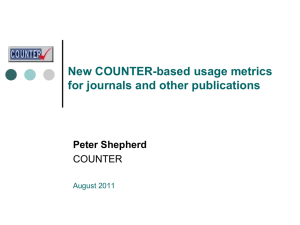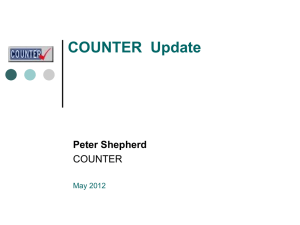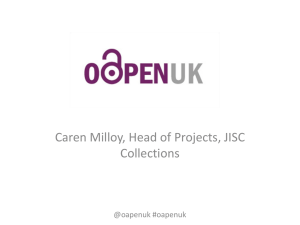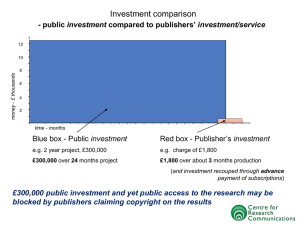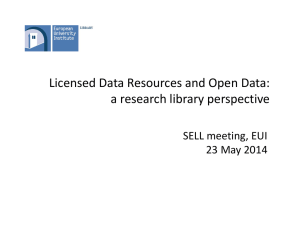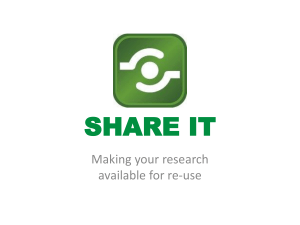For the complete presentation, please click Here
advertisement
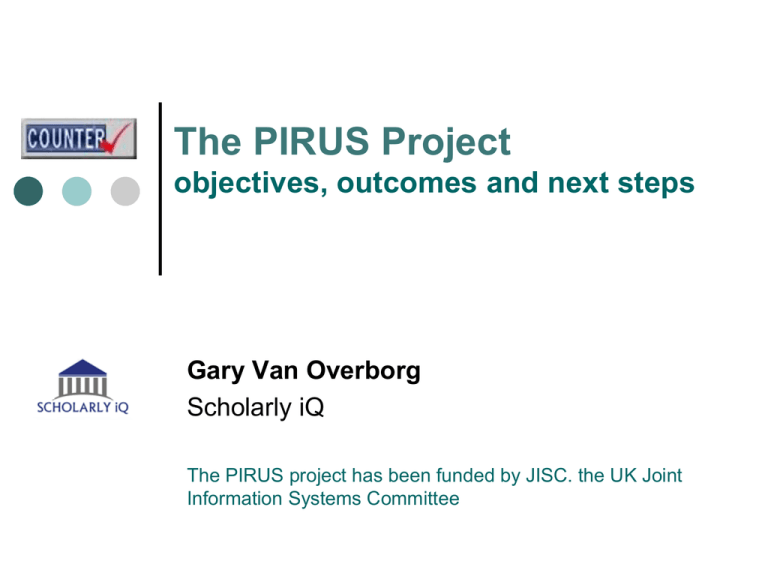
The PIRUS Project objectives, outcomes and next steps Gary Van Overborg Scholarly iQ The PIRUS project has been funded by JISC. the UK Joint Information Systems Committee PIRUS: why now? Increasing interest in article-level usage Journal articles are now available in a range of locations: The main journal website Aggregator sites ( OVID, ProQuest, etc) Subject repositories ( PubMed Central, etc) Institutional Repositories Authors and funding agencies are increasingly interested in a reliable, global overview of usage of individual articles Online usage becoming an alternative, accepted measure of article and journal value PIRUS: why now? Article-level usage metrics now more practical Implementation by COUNTER of XML-based usage reports makes more granular reporting of usage a practical proposition Implementation by COUNTER of the SUSHI protocol facilitates the automated consolidation of usage data from different sources. PIRUS: support for the principle of reporting article-level usage Authors: very positive. Evidence from PLoS experience and growing numbers of requests to other publishers for individual article usage reports Publishers: support growing, as they receive more requests from authors for usage data on individual articles. Repositories: mixed. Some question the need for a global standard. Others are concerned about costs. Research institutions: positive. Interested in measures of the value and impact of research outputs PIRUS: benefits Reliable usage data will be available for journal articles, wherever they are held Repositories will have access to new functionality from open source software that will allow them to produce standardised usage reports from their data Publishers will be able to provide their authors with more reliable usage statistics The authoritative status of PIRUS usage statistics will enhance the status of article-level usage reports The standard can be extended to cover other categories of content stored by repositories PIRUS: mission and project aims Mission To develop a global standard to enable the recording, reporting and consolidation of online usage statistics for individual journal articles hosted by Institutional Repositories, Publishers and other entities Project aims Develop COUNTER-compliant usage reports at the individual article level Create guidelines which, if implemented, would enable any entity that hosts online journal articles to produce these reports Propose a model for a Central Clearing House (CCH) in which these reports might be consolidated at a global level in a standard way. PIRUS: nature and mission of the Central Clearing House One global CCH Cost-effective Industry is global, with global standards Easier to set and modify standards Simpler interface with publishers and repositories Can be outsourced Existing organizations exist with the required capabilities Scenarios to be supported See next slide…….. Step 1: a fulltext article is downloaded Step 2: tracker code invoked, generating an OpenURL log entry Scenario A Step A1: OpenURL log entries sent to CCH responsible for creating and consolidating the usage statistics Step A2: logs filtered by COUNTER rules Step A3: COUNTER-compliant usage statistics collected and collated per article (DOI) in XML format Step A4: COUNTER compliant usage statistics available from CCH to authorized parties Scenario B Scenario C Step B1: OpenURL log entry sent to local server Step C1: OpenURL log entry sent to local server Step B2: OpenURL log entries harvested by CCH responsible for creating and consolidating usage statistics Step C2: logs filtered by COUNTER rules Step B3: logs filtered by COUNTER rules Step B4: COUNTER-compliant usage statistics collected and collated per article (DOI) in XML format Step B5: COUNTER compliant usage statistics available from CCH to authorized parties Step C3: COUNTER-compliant usage statistics collected and collated per article (DOI) in XML format Step C4: COUNTER compliant usage statistics available from repository or publisher to CCH PIRUS: CCH operating principles The “bucket” of usage data should be controlled by the participants - they can decide whether to compile the usage reports themselves or to delegate that role to the CCH Access to the CCH should be limited to authorised parties Usage reports must state the sources from which they have been compiled to ensure transparency PIRUS2: role of CCH Role 1: consolidated processing (applies to most repositories and to some publishers) Relies on all journal article downloads invoking a tracker code that sends data to a single big bucket Requirements can be met by various counting or analytics packages Compliance with the standard can be checked by the “data gathering” audit All data in one place allows mining - deeper insights into data and easy integration of other projects, e.g. JUF Publishers who use this option could lose control of own data and report compilation Consolidated usage reports can be generated by the CCH Single data standard, not necessarily data tool Terms and Conditions could handle some aspects of this All steps are auditable: Data gathering • • Counting • Correct interpretation of data packets received Compilation of usage reports • Process of sending data packet to bucket Profile of data packet – does it meet standards? Correctness, completeness Audit overhead lower due to standard system PIRUS2: role of the CCH Role 2: distributed processing (applies to most publishers and some repositories) Relies on repositories and publishers gathering data in own buckets All steps are auditable: Publishers • count and produce own usage reports according to the specifications of Article Report 1. Repositories • count and produce own usage reports and send reports to CCH OR • send data to CCH who count and produce usage reports (and return to repositories?) CCH sends repository reports to publishers Data gathering • Process of sending data packet to bucket • Profile of data packet – does it meet standards? Counting • Correct interpretation of data packets received Compilation of usage reports • Correctness, completeness Many possible risk areas due to multiple supply points PIRUS2: outputs from the CCH Usage reports for publishers Usage reports for repositories Usage reports for research institutions Key requirements: Set of core reports Flexibility in outputs PIRUS2: example of a report PIRUS: project outcomes Technical: a workable technical model for the collection, processing and consolidation of individual article usage statistics has been developed. Organizational: an organizational model for a Central Clearing House that would be responsible for the collection, processing and consolidation of usage statistics has been proposed. Economic: the costs for repositories and publishers of generating the required usage reports, as well as the costs of any central clearing house/houses have been calculated and a model for recovering these costs has been proposed . For full report on the PIRUS project go to: http://www.projectcounter.org/News/Pirus2_oct2011.pdf PIRUS: Next steps The outcomes of the PIRUS project provide a solid technical and organizational model on which to base a standard and process for the recording and reporting of usage at the individual article level. The next steps to be taken are as follows: Publication of a draft PIRUS Code of Practice Based on COUNTER standards Reporting usage at the individual article level Specification of a structure for the ongoing governance of PIRUS Stepwise implementation of the CCH PIRUS: Next steps - a draft PIRUS Code of Practice The Code of Practice will be consistent with COUNTER and will provide: A list of Definitions and other terms that are relevant to PIRUS A methodology for the recording and reporting of usage at the individual article level, including specifications for the metadata to be recorded, and the content types and article versions whose usage may be counted. Specifications for the PIRUS usage reports Data processing rules to ensure that the usage data are credible, consistent and compatible Specifications for the independent auditing of the PIRUS reports A description of the role of the Central Clearing House The draft Code of Practice will be published in early 2012, for comments Publishers are already requesting a PIRUS Code of Practice and will be able to test the draft Code of Practice using their own data PIRUS: governance Principles Independent, not-for-profit organization International Representation of the main stakeholder groups Repositories Publishers Research Institutions Role Define and implement PIRUS mission Strategic oversight Set and monitor standards Set fees and manage finances Select and monitor suppliers PIRUS: Next steps -Stepwise implementation of the CCH In view of the technical challenges that the CCH faces, its strong dependency on other initiatives, such as ORCID and institutional identifier and the requirements for publishers to re-engineer some of their processes, it will be prudent to implement the CCH in two Stages: Stage 1: gather and consolidate usage data only from repositories and provide the usage statistics generated by the CCH to publishers and other authorised bodies Work will begin on Stage 1 in 2012 Stage 2: and collect usage data from publishers that wish to use the CCH service for this purpose The timetable for implementation of Stage 2 will depend on the outcomes of Stage 1 PIRUS: Further information and updates For further information and updates on the PIRUS project: http://www.projectcounter.org/news.html For further information and updates on Scholarly iQ: http://www.scholarlyiq.com
